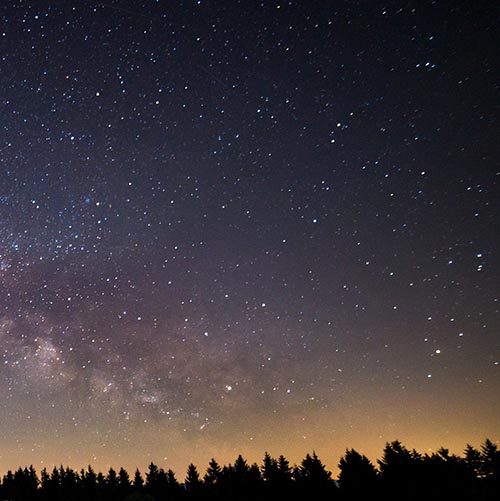
Listen to this Episode:
- From this webpage:
- Find the media player located under the episode picture.
- Click on the green triangle to listen to the audio for this episode.
- From your favorite podcast listening platform:
- Search for “Backyard Ecology.”
Show notes:
Once upon a time, the moon was the brightest object in the night sky followed by the stars. However, that’s no longer the case. Today the night sky is so brightly lit by artificial lights sources that the majority of people living in North America can no longer see the Milky Way from their yards. Even for those of us who can see the Milky Way, it is often greatly dimmed by nearby artificial light sources or sky glow caused by the closest city or town.
Does it matter if our view of the stars is diminished? Actually, it does. All of that extra light that is obscuring the stars is called light pollution and it has significant impacts on a wide variety of wildlife species and can even affect us. In this episode of the Backyard Ecology podcast, we talk with Murry Burgess. Murry is an ornithologist, urban ecologist, and children’s author. She is also working on her PhD at North Carolina State University where she is studying the effects of light pollution on barn swallows.
Murry and I start our conversation by defining light pollution and discussing some of its sources. We then talk about some of the different impacts it can have on birds, insects, and even us. During the conversation, Murry shares with us some of the findings from her research with barn swallows and how those results are likely to translate to other bird species. We also discuss some of the ways we can minimize light pollution, both at an individual scale and at larger community-wide scales. And while most of our conversation focuses on light pollution, we frequently interweave other stories and topics related to our mutual passions for wildlife and inspiring others to appreciate the nature around them.
Links:
- Murry’s contact information:
- Email: mburges5@ncsu.edu
- Website: https://www.mlburgess.org/
- Blog: http://notasnakedoctor.squarespace.com/
- Instagram: https://www.instagram.com/murryloub/?hl=en
- Twitter: https://twitter.com/murryloub
- Backyard Ecology’s website: https://backyardecology.net
- Related Backyard Ecology episodes:
- Lightning bugs and Fireflies: A conversation with Lynn Faust, Part 1: https://www.backyardecology.net/lightning-bugs-and-fireflies-a-conversation-with-lynn-faust-part-1/
- Lightning bugs and Fireflies – A conversation with Lynn Faust, Part 2: https://www.backyardecology.net/lightning-bugs-and-fireflies-a-conversation-with-lynn-faust-part-2/
- Reconnecting with the Natural World at Night: https://www.backyardecology.net/reconnecting-with-the-natural-world-at-night/
- Backyard Ecology blog: https://www.backyardecology.net/blog/
- Backyard Ecology’s Patreon page: https://www.patreon.com/backyardecology
- Subscribe to Backyard Ecology emails: https://www.backyardecology.net/subscribe/
- My email: shannon@backyardecology.net
Episode image:
- The Milky Way with sky glow on the horizon.
- Photo credit: EvgeniT, cc-0

Backyard Ecology: Exploring Nature in Your Backyard
Nature isn’t just “out there.” It’s all around us, including right outside our doors. Hi, my name is Shannon Trimboli, and I am the host of Backyard Ecology. I live in southcentral Kentucky and am a wildlife biologist, educator, author, beekeeper, and owner of a nursery specializing in plants for pollinators and wildlife conservation. I invite you to join me as we ignite our curiosity and natural wonder, explore our yards and communities, and improve our local pollinator and wildlife habitat. Learn more or subscribe to my email list at www.backyardecology.net.

Leave a Reply